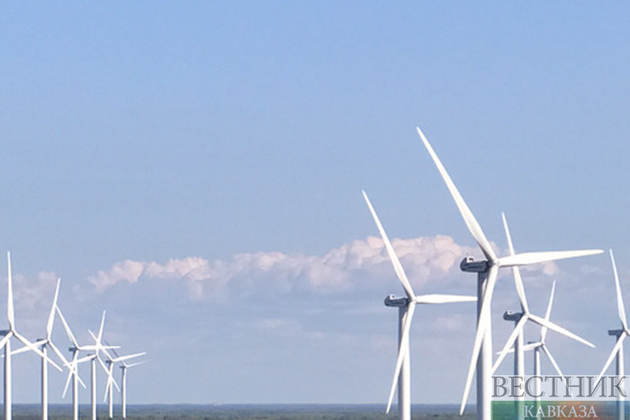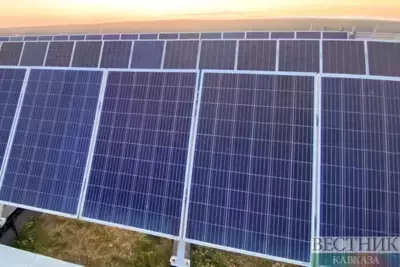Kazakhstan’s government has set an ambitious goal of reaching net-zero emission by 2060, planning to gradually reduce its reliance on coal, which is the main source currently for electricity generation, but the transition to renewables in the Central Asian state has exposed key problems of the power industry, such as imbalances in the system and lack of maneuvering capacity, Victor Kovalenko, head of Climate Change and Sustainability Services in Central Asia, Caucasus and Ukraine, EY, told New Europe in Tashkent.
“It is quite difficult topic for the country because Kazakhstan is very rich in coal reserves, it is quite cheap and the most of energy sector is relying on coal for coal-fired generation, electricity, and heat as well,” he said in an interview on the sidelines of Energy Week Central Asia & Mongolia in the Uzbek capital Tashkent on April 26.
He spoke about challenges and prospects of green energy development in Kazakhstan. “Let’s start with heat. In many countries when we’re talking about renewables, we’re talking about electricity generation but for Kazakhstan considering its climate it’s important not forget about heat generation because of very cold weather in the winter and generating heat with renewables is quite a difficult task so there are a lot of combined heat power stations in Kazakhstan which are based on coal, and this should be also reflected in any energy transition strategy,” Kovalenko said. “Considering how the energy sector in Kazakhstan is structured you cannot just switch off coal power stations in one moment because the energy system will just be destroyed. So, the point that during the process of phasing out coal two issues should be solved: first, who will take the base load in generation and second who will be the maneuvering capacity,” the Ernst & Young expert added.
Based in Almaty, Kazakhstan, Kovalenko said the first task will be partially solved by nuclear power stations which can generate electricity and, at the same, heat and this type of technology can take the base load in the energy system. “But the problem is with maneuvering capacity. First, you are phasing out coal power stations, second you are increasing the share of renewables in your energy mix. Both tasks require to install new base load generation and new maneuvering capacity,” he said. “With base load it’s a bit easier because you can at least consider nuclear. For maneuvering it’s much more difficult because maneuvering capacity can be hydro, and it can be gas power stations. So, Kazakhstan is already facing deficit of natural gas and unfortunately it doesn’t have such strong reserves of natural gas like Uzbekistan,” he said. Moreover, he said that while the Kazakhstan has hydropower potential, it needs massive investments to develop hydropower plants.
He called for a carefully planned model to phase out coal. “One of the solutions is smooth phasing out of the coal generation, not building new generating capacities but when some capacities are phased out to substitute them by renewables,” Kovalenko said, adding that, at the same time, the country needs to boost maneuvering generation capacity.
He explained that maneuvering capacity is important because renewable energy generation is unstable. “Just because of natural factors you cannot expect that, for example, wind power stations will generate the same volume during the whole day each day, each hour, each minute, each second. It’s with increases and decreases but the consumption is stable,” he said. “So, something should stabilize this unstable generation just to have stable electricity in the grid,” he added. Full load electricity generation in the hydropower, gas-power fired plants could be transferred directly to the grid during the peak demand, he said.
During Energy Week Central Asia & Mongolia in Tashkent, Nurlan Kapenov, Chairman of the Board of Directors of the Qazaq Green RES Association, also noted that it takes time and serious investment to solve the maneuvering capacity deficit. Kaperov said Kazakhstan joined the global movement to achieve carbon neutrality targets at the end of 2020. Kazakhstan currently has a high level of depreciation of funds in the coal energy sector, and the retiring capacities need to be replaced by renewable energy sources, primarily solar and wind generation, he said.
In four years, the Association has achieved the following results: 134 renewable energy facilities operate in the country, generating about 4% of electricity. “The development of green energy in Kazakhstan has exposed key problems of the power industry, such as imbalances in the system, lack of maneuvering capacity, dependence on neighboring states, depreciation of equipment, isolation of the Western zone, energy security of our country,” Kaperov said.
During the same conference in Tashkent, Ainur Sospanova, chairwoman of the Board of the Qazaq Green Renewable Energy Association, said RES facilities will generate about 6% of electricity in Kazakhstan by 2026. The association has achieved its goals, Sospanova said, adding that renewable energy sources currently produce about 4% of Kazakhstan’s electricity. “We hope that all contracted volumes of RES facilities construction will be commissioned,” she said.
In 2022, Kazakhstan will formulate the Doctrine of achieving carbon neutrality of the Republic of Kazakhstan until 2060, she said. “Currently, the public and the government are discussing this document because we understand that it determines, in general, the further economic course of our country,” Sospanova said.
Meanwhile, Kovalenko told New Europe that Kazakhstan is studying Uzbekistan because the latter’s energy mix and the energy system is already much more ready for maneuvering capacity and for increasing of renewables just because most of the electricity generation in Uzbekistan is gas-fired based. The factor which may create more demand for investments in Kazakhstan is the significant share of outdated capacity. The time when these old capacities should be phased out will, be very soon, he said. Kazakhstan will need to build new capacity to substitute the plants that are phasing out or invest into deep modernization of existing capacity, Kovalenko said.
The choice is to build new capacities to substitute those that are phasing out or to modernize existing ones. “The point is if you are really phasing out these capacities and invest in new ones the question in which type of generation you will invest – renewables, gas, clean coal, nuclear or something else,” Kovalenko said.
Turning to interconnection of energy systems in Central Asia, Kovalenko reminded that was a key topic discussed during the conference in Tashkent. “That was exact the question that was asked today: Maybe with the goal to implement more renewables, it’s time to sit together again and think about the unified Central Asia unified energy system and build renewable capacities in the unified energy system rather than to make it in a country-by-country basis building their own networks,” he said. “The potential for foreign investment in Central Asia is huge. To build these capacities you need significant investment. For example, if the government of Kazakhstan will publish these three-year forecasted auctions and investors know in a year-by-year basis the capacities that they will be built so they can plan their investments,” Kovaleko said.
During the Soviet Union there was a unified energy system of Central Asian countries. “It’s important for the region and it’s a unique chance for the region because this is not something that will be built from scratch. It is coming back to what was already in place in previous times and the energy systems of the region were created from scratch considering that there would be a unified energy system, he said. One of the problems here is that building a unified system of Central Asia countries is conflicting with Eurasia Energy Union because for example Kazakhstan, Kyrgyzstan and Russia are in that energy union,” Kovaleko said, adding, “And those are two conflicting ideas and completely opposite vectors. And I agree with what was said in our panel that politicians should sit together and decide in which direction countries would go whether to integrate into single energy market in Eurasia Energy Union or to build a single energy system of Central Asia”.
















